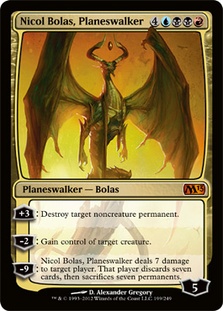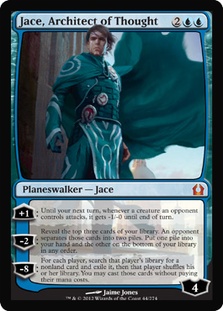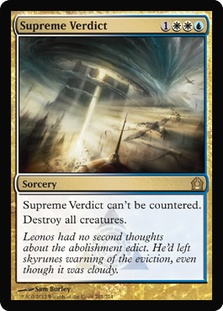“[Reid] seems like a man who is going to be Farseeking an above-average amount of the time. He’s probably gonna want us to go get some Overgrown Tombs and Breeding Pools in control decks.”
–Patrick Chapin in July*
Patrick Chapin: a man who knows me better than I know myself. I couldn’t say that I’d ever played or seriously been interested in playing a green-based control deck before in my life. At the time, his Farseek comment struck me as odd.
Well, Patrick’s obscure prediction from three months ago had slipped my mind until this week, when I finally set my sights on new Standard. And guess what… I want us to get some Hallowed Fountains and Temples Gardens into control decks.
But I’m getting ahead of myself! I’m not Patrick Chapin, and many of my readers aren’t either. I myself had to go through a long and rigorous process before I came to this revelation. Today, I’d like us to walk through this process together, and by the end, hopefully everyone will understand why I want us to put Hallowed Fountains and Temple Gardens in control decks.
We’re gonna consider the challenges that Return to Ravnica Standard is likely to present and the best ways we can approach them. Step one, though, is to recognize what tools are available to us.
Finishers
The top priority for any control deck is its end game. If we fail to make the end game strong enough, everything else falls apart. What’s the point of protecting yourself, making your land drops, and preparing to face every possible threat if you’re still able to flood out and lose once you get to the late game? If we have a strong late game and a weak early game, we might have a mediocre deck. If we have a strong early game and a weak late game, we have a deck that doesn’t work. We have nothing. Let’s be sure to avoid that.
One way, of course, to have a strong late game is simply to load up on powerful cards. Here’s my list of the most appealing “finishers” for a control deck in new Standard. These are the cards that will allow us to pull ahead as the game drags on or close things out once we establish control.
Nephalia Drownyard
Staff of Nin
Entreat the Angels
Sigarda, Host of Herons
Armada Wurm
Sphinx’s Revelation
Gisela, Blade of Goldnight
Lingering Souls
Sorin, Lord of Innistrad
Garruk Relentless
Garruk, Primal Hunter
Thragtusk
Elderscale Wurm
Huntmaster of the Fells
Vraska the Unseen
Jace, Architect of Thought
Jace, Memory Adept
Tamiyo, the Moon Sage
Lone Revenant
Sphinx of the Chimes
Niv-Mizzet, Dracogenius
Nicol Bolas, Planeswalker
Chandra, the Firebrand
Olivia Voldaren
Liliana of the Veil
Liliana of the Dark Realms
Bloodline Keeper
Bloodgift Demon
Griselbrand
That’s a lot to work with, particularly in terms of planeswalkers—like Jace and Tamiyo—and creatures—like Lone Revenant and Niv-Mizzet—that can generate value each turn they stay on the board. We’ll have to postpone any final decisions about finishers, though, until we consider other aspects of the deck and what the format is going to demand out of a finisher.
Card Drawing
It’s certainly possible that some kind of ramp or planeswalker midrange strategy will be competitive in Return to Ravnica Standard. A deck like that could use early game defense and a large collection of the above cards to take over a game. For today, though, what we’re interested in is blue control. Card drawing is an extremely valuable part of any deck that’s geared for the long game. Not only does it help us to tighten our grip on the late game and prevent us from flooding out, but it also helps us to smooth out our draw in the early turns and find the answers we need to survive. This format has a plethora of good card draw options, so I’m confident that blue control is a good place to be.
Think Twice
Desperate Ravings
Forbidden Alchemy
Sign in Blood
Divination
Inspiration
Amass the Components
Thoughtflare
Sphinx’s Revelation
Diabolic Revelation
Jace, Architect of Thought
Jace, Memory Adept
Between the life loss and the color-intensive mana cost, I don’t envision a blue deck wanting Sign in Blood. Jace, Memory Adept is worse than Jace, Architect of Thought for anything besides a dedicated mill deck, and playing more than four copies would be very extreme. Diabolic Revelation is generally worse than Sphinx’s Revelation for a deck that has access to both blue and white.
After scratching those three off the list, we’re left with nine card draw options of—in my opinion—comparable power level. Some are new cards, some are old cards that we’re used to seeing, and some—Divination and Amass the Components—are old cards that we aren’t used to seeing. Those cards used to sit on the sidelines and watch their instant speed cousins get all the glory, but that no longer needs to be the case. Between the printing of Cavern of Souls and the rotation of Mana Leak, the incentive to play permission is at a low point, and that reduces the need for instant speed card drawing.
I believe there’s a lot of flexibility in which card draw spells we can choose, and a lot of it will depend on a given deck’s mana curve. It’s worth noting that white, red, and black all offer playable card draw spells but that there’s already enough in mono-blue that card draw alone won’t be a strong draw towards any of those colors.
Sweepers
The final key ingredient for a control deck is a good board sweeper. With the brutal efficiency of creatures in modern Magic, we won’t have the time, the cards, or the mana to defend ourselves using only spot removal.
Supreme Verdict
Terminus
Planar Cleansing
Bonfire of the Damned
Magmaquake
Blasphemous Act
Mizzium Mortars
Rolling Temblor
Street Spasm
Mutilate
Barter in Blood
Here we finally feel ourselves being pulled towards a color other than blue. Red has one-sided sweepers that are immensely powerful for a deck that plays its own creatures. In exchange, though, they’re overcosted for a pure control deck. There are no Pyroclasms, no Whipflares, and no Slagstorms as cheap ways to help us get to the late game. Aside from the unimpressive Rolling Temblor, red’s sweepers can’t even handle a Geist of Saint Traft very well!
White is the place to be here. Supreme Verdict is high in the running for best board sweeper ever printed, and it comes at a very nice spot on the mana curve. Terminus and Planar Cleansing have powerful and unique effects that could potentially be very useful under certain conditions also.
The New Standard Metagame
Now we know our assets and our options. Still, though, we’re just shooting in the dark unless we can get a rough outline of what threats we’ll be facing.
If there’s one sure thing, it’s that Zombies will be a top deck right out of the gates. It’s an easy port of a successful deck that already exists in Standard and Block Constructed; it loses almost nothing and has some potentially big gains in shocklands and Lotleth Troll. Zombies is not difficult to beat with a control deck, but we will definitely, definitely lose to Zombies unless we build with it in mind.
Thragtusk is among the best cards in Standard and is the single best card against Zombies. It’s good in a wide range of decks and is easily splashable. If there’s a second sure thing, it’s that there will be plenty of Thragtusk decks in new Standard, commonly with Restoration Angel as well. What Thragtusk means for control is that we cannot run on thin margins; it’s very difficult to grind out Thragtusks with Divinations and removal spells. There’s no good way to handle a Thragtusk, so the best approach is to build a deck that doesn’t care about it. We want an end game that goes completely over the top of Thragtusks and Restoration Angels.
Though Delver in its current form will no longer exist, Geist of Saint Traft is another of the format’s best cards, and mana fixing is good enough to ensure that it will still see plenty of play. Supreme Verdict, Rolling Temblor, legend rule, and blocking with something like Huntmaster of the Fells are the best answers to Geist.
There will be decks built around every legal planeswalker (sorry, not you Tibalt). Pithing Needle, Oblivion Ring, Detention Sphere, Planar Cleansing (though not in combination with the first three), and permission are the best answers to opposing planeswalkers. Creatures and burn can be acceptable too.
There will likely be some sort of Bant Midrange deck, Miracles, Mono-Black Control, and Tokens, all in various incarnations.
We need not worry about all of those decks (in fact, blue control will have a colossal inherent advantage against many of them), but we do need to respect a couple of the unique and deadly threats of new Standard.
- Zombies
- Geist of Saint Traft
- Thragtusk
- Planeswalkers
Beating Zombies
Zombies can be brutally fast; we’ll need relevant early plays. Zombies do not like to stay dead; we’ll need Terminus or removal that exiles creatures. Zombies has reach in the form of burn; we’ll need life gain.
Blue and white provide a good start, with Terminus, Detention Sphere, Jace, Architect of Thought, and Sphinx’s Revelation offering a nice shell. It’s lacking in the “relevant early plays” department, however, so that’s what we should look for in a third color. Red offers Pillar of Flame, and green offers Farseek. With Pillar being the format’s most efficient early game removal and Farseek being the single best way to smooth out U/W’s mana curve, I’d rate the two as roughly equal additions to the control shell. The tiebreaker is that where red can offer some interesting but less-than-crucial card draw options, green offers Thragtusk, which is the best way to stabilize against Zombies and other beatdown decks.
Black offers some appealing fringe options but nothing indispensable and nothing that would improve the Zombie matchup (other than maybe Sorin, Lord of Innistrad), so we can set the color aside for the time being.
The shell of our deck should look like:
Jace, Architect of Thought
Tamiyo, the Moon Sage
Supreme Verdict
Terminus
Detention Sphere
Think Twice
Sphinx’s Revelation
Farseek
Thragtusk
Winning the Game
The final question to answer is that of how to officially win the game. Jace, Tamiyo, and Sphinx’s Revelation do a nice job of pulling us ahead in the late game, but they can only actually kill the opponent in very roundabout ways. Because of Zombies’ reach and Thragtusk’s persistence, we should look for a trump card that can drop the hammer on an opponent who just doesn’t want to give in.
This is where we’ll really miss M12 and Scars of Mirrodin block. The Titans are gone, Consecrated Sphinx is gone, Wurmcoil Engine is gone, and Karn Liberated is gone. What we have left is a bunch of midrange planeswalkers and value creatures. Sure, Olivia Voldaren and Niv-Mizzet, Dracogenius will dominate if they stay on the table for a few turns, but they lack the ability to immediately swing a game that something like a Grave Titan had.
Entreat the Angels is the most powerful win condition available, and it’s downright insane if you can miracle it at the right time. I believe it would be possible to make a dedicated Miracle deck like Alexander Hayne’s Pro Tour-winning Block Constructed deck, but that’s a job for another day. For an ordinary control deck, using Jace and Sphinx’s Revelation as card draw, an unacceptably low number of the cards we see will be under miracle conditions. Given that, Entreat is overcosted and unexciting.
Next, we can look to Gisela, Blade of Goldnight as a trump card. No army of any size is going to stand a realistic chance against Gisela. However, Zombies has plenty of removal, Oblivion Ring and Detention Sphere are sure to be popular cards, and there’s still the dreaded Zealous Conscripts. Turning on these cards feels like an unacceptable liability.
We could try to fight the good fight with Armada Wurm, or Niv-Mizzet, or any of a dozen other things, but I have one more idea that might just be crazy enough to work.
Why Win the Game at All?
This idea can only be possible because of the existence of Sphinx’s Revelation. Simultaneously generating massive card advantage, digging deep into your library, and pulling yourself out of reach of creatures and burn represents everything a control deck wants to be doing in the late game. Most importantly, though, is the fact that each progressive Revelation becomes more powerful until there comes a point where no amount of lucky topdecks from your opponents can possibly keep up with you.
By recycling removal, permission, and Sphinx’s Revelations, we can ensure victory 100% without officially having to kill our opponent.
Creatures (4)
Planeswalkers (5)
Lands (26)
Spells (25)

Elixir of Immortality allows us to recycle our deck and ensures victory as the game drags on. Importantly, it does so while only taking up a single slot and having no adverse impact on the mana curve. Elixir is also a reasonable card in its own right as a cheap source of life gain that is very welcome against Zombies. Note, though, that we need not officially deck our opponents, and we’re not in trouble if the Elixir gets countered or destroyed. We will most commonly win by repeatedly clearing the board and attacking with an uncontested Thragtusk. We can also win with Jace’s ultimate by pulling a powerful card out of the opponent’s library. Elixir is just there as insurance.
A huge side benefit of this plan is making opposing creature removal dead. The only thing they can do with it is double Murder a Thragtusk while still allowing us to gain five life.
The general game plan for the ultra-late game is to tick up planeswalkers and repeatedly clear the board. The time to crack Elixir of Immortality is the turn before a big Sphinx’s Revelation, if and only if there’s another copy of Revelation in the graveyard. The goal, of course, is to use one Revelation to draw into another.
An annoying side effect of the Elixir plan (although I certainly won’t lose any sleep over it) is that it reduces the value of flashback spells. We should omit Snapcaster Mage since flashing back our most powerful spells will only weaken our deck as we reshuffle. Think Twice is not ideal for the same reason, but it fits the mana curve so well that we should make an exception for it. If we were able to free up one or two slots, Divination would be the next card to add.
While I could see time becoming an issue for this deck in a tournament setting, I do think things would be manageable. An opponent who elects not to concede in the face of repeated Sphinx’s Revelations for ten will put himself at risk of losing the match 1-0-1. Even if things go awry, our sideboard packs a number of heavy-hitting creatures that can steal a game in a timely fashion.
The Decklist
Shocklands are bad for a deck like this since we want all of our mana available every turn after the first, but we also cannot afford to take damage from our lands. A few copies are worthwhile simply to increase the value of Farseek.
As previously mentioned, the value of permission is at an all-time low, but for a deck that wants to lock up the late game like this a small amount is integral. Essence Scatter isn’t embarrassing, but Cavern of Souls makes it unreliable, and the real reason for permission is not creature decks anyway. As the main purpose is late game insurance, the extra mana on Dissipate over Negate is not a major problem, so we should favor the more powerful and versatile permission spell at least in the maindeck.
Azorius Charm is a relatively weak card, but in these colors we have slim pickings in terms of cheap removal. In my (limited) testing, an early flipped Delver was one of the biggest problems for this deck and having one extra way to reset it is welcome. Azorius Charm also represents an instant speed answer, a way to cycle towards Sphinx’s Revelation, and a potential source of life gain by giving Thragtusk lifelink.
The sideboard is pretty general with the goal of being able to handle the threats of a diverse field. With Phantasmal Image gone, the hexproof legends skyrocket in value and have the potential to steal easy games from opponents who sideboard out their sweepers. They also serve as great ways to pressure planeswalkers and a way to adjust our game plan according to the round clock.
So that’s the process by which Mr. Chapin’s prediction has come to pass—the process by which I find myself, today, recommending a Farseek control deck. Return to Ravnica Standard still has plenty of time to evolve and perhaps to surprise us, but I do believe that this is an archetype that has potential. At worst, it’s a good jumping off point for anyone interested in pursuing control.
* http://www.starcitygames.com/events/120729_buffalo.html (32 seconds in)
 |
I am Rakdos. I’m extreme and uncompromising. I want power for the sake of power, and no amount will ever be enough. I refuse to be shackled by rules, and I have no interest in acting the way people think I should act or playing MTG the way people think I should play MTG. In game, my goal is to put my opponent’s back against the wall and give them no room to breathe. I deprive them of resources, wait for them to stumble, and finish them quickly. |




